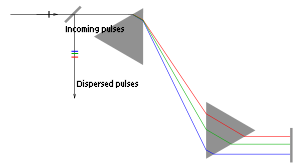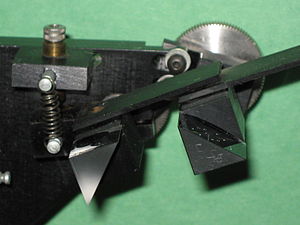- Multiple-prism dispersion theory
-
The first description of multiple-prism arrays, and multiple-prism dispersion, was given by Newton in his book Opticks.[1] Prism pair expanders were introduced by Brewster in 1813.[2] A modern mathematical description of the single-prism dispersion was given by Born and Wolf in 1959.[3] The generalized multiple-prism dispersion theory was introduced by Duarte and Piper[4][5] in 1982.
Contents
Generalized multiple-prism dispersion equations
The generalized mathematical description of multiple-prism dispersion, as a function of the angle of incidence, prism geometry, prism refractive index, and number of prisms, was introduced as a design tool for multiple-prism grating laser oscillators by Duarte and Piper,[4][5] and is given by
This multiple-prism arrangement is used with a diffraction grating to provide tuning in a dye laser.
where
Here, ϕ1,m is the angle of incidence, at the mth prism, and ψ1,m its corresponding angle of refraction. Similarly, ϕ2,m is the exit angle and ψ2,m its corresponding angle of refraction. The two main equations give the first order dispersion for an array of m prisms at the exit surface of the mth prism. The plus sign in the second term in parenthesis refers to a positive dispersive configuration while the minus sign refers to a compensating configuration.[4][5] The k factors are the corresponding beam expansions, and the H factors are additional geometrical quantities. It can also be seen that the dispersion of the mth prism depends on the dispersion of the previous prism (m - 1).
These equations can also be used to quantify the angular dispersion in prism arrays, as described in Isaac Newton's book Opticks, and as deployed in dispersive instrumentation such as multiple-prism spectrometers. A comprehensive review on practical multiple-prism beam expanders and multiple-prism angular dispersion theory is given by Duarte.[6]
More recently the generalized multiple-prism dispersion theory has been extended to higher order phase derivatives using a Newtonian iterative approach.[7] This extension of the theory enables the evaluation of the Nth higher derivative via an elegant mathematical framework. Applications include further refinements in the design of prism pulse compressors and nonlinear optics.
For a single right-angled prism (m = 1) with the beam exiting normal to the output face, that is ϕ2,m equal to zero, the Duarte-Piper equation reduces to[6]
Applications
The first application of this theory was to evaluate the laser linewidth in multiple-prism grating laser oscillators.[4] Adding the grating contribution to the dispersion renders an equation for the total intracavity angular dispersion.[4] It is this total dispersion that plays an important role in the linewidth narrowing of pulsed tunable lasers through the equation
where the angular dispersion is the quantity in parenthesis (elevated to –1). Although originally classical in origin, in 1992 it was shown that this cavity linewidth equation can also be derived from from quantum principles.[8]
In 1987 the multiple-prism angular dispersion theory was extended to provide explicit second order equations directly applicable to the design of prismatic pulse compressors.[9] The generalized multiple-prism dispersion theory is applicable to:
- laser microscopy,[10][11]
- narrow-linewidth tunable laser design,[12]
- prismatic beam expanders[4][5]
- prism compressors for femtosecond pulse lasers.[13][14][15]
See also
- Beam expander
- Laser linewidth
- Multiple-prism grating laser oscillator
References
- ^ I. Newton, Opticks (Royal Society, London, 1704).
- ^ D. Brewster, A Treatise on New Philosophical Instruments for Various Purposes in the Arts and Sciences with Experiments on Light and Colours (Murray and Blackwood, Edinburgh, 1813).
- ^ M. Born and E. Wolf, Principles of Optics, 7th Ed. (Cambridge University, Cambridge, 1999).
- ^ a b c d e f F. J. Duarte and J. A. Piper, "Dispersion theory of multiple-prism beam expanders for pulsed dye lasers", Opt. Commun. 43, 303–307 (1982).
- ^ a b c d F. J. Duarte and J. A. Piper, "Generalized prism dispersion theory", Am. J. Phys. 51, 1132–1134 (1982).
- ^ a b F. J. Duarte, Tunable Laser Optics (Elsevier Academic, New York, 2003) Chapter 4.
- ^ F. J. Duarte, Generalized multiple-prism dispersion theory for laser pulse compression: higher order phase derivatives, Appl. Phys. B 96, 809-814 (2009).
- ^ F. J. Duarte, Cavity dispersion equation: a note on its origin, Appl. Opt. 31, 6979-6982 (1992).
- ^ F. J. Duarte, "Generalized multiple-prism dispersion theory for pulse compression in ultrafast dye lasers", Opt. Quantum Electron. 19, 223–229 (1987)
- ^ B. A. Nechay, U. Siegner, M. Achermann, H. Bielefeldt, and U. Keller, Femtosecond pump-probe near-field optical microscopy, Rev. Sci. Instrum. 70, 2758-2764 (1999).
- ^ U. Siegner, M. Achermann, and U. Keller, Spatially resolved femtosecond spectroscopy beyond the diffraction limit, Meas. Sci. Technol. 12, 1847-1857 (2001).
- ^ F. J. Duarte, Tunable Laser Optics (Elsevier Academic, New York, 2003) Chapter 7.
- ^ L. Y. Pang, J. G. Fujimoto, and E. S. Kintzer, Ultrashort-pulse generation from high-power diode arrays by using intracavity optical nonlinearities, Opt. Lett. 17, 1599-1601 (1992).
- ^ K. Osvay, A. P. Kovács, G. Kurdi, Z. Heiner, M. Divall, J. Klebniczki, and I. E. Ferincz, Measurement of non-compensated angular dispersion and the subsequent temporal lengthening of femtosecond pulses in a CPA laser, Opt. Commun. 248, 201-209 (2005).
- ^ J. C. Diels and W. Rudolph, Ultrashort Laser Pulse Phenomena, 2nd Ed. (Elsevier Academic, New York, 2006).
External links

This science article is a stub. You can help Wikipedia by expanding it.










